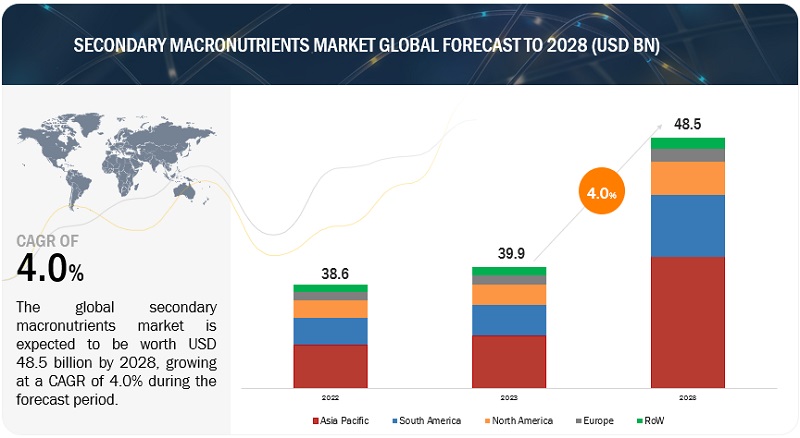The secondary macronutrients market size was valued at $38.6 billion in 2022 and is projected to grow from $39.9 billion in 2023 to $48.5 billion by 2028, representing a CAGR of 4.0% during the forecast period (2023-2028). This growth is primarily driven by an increasing deficiency of secondary macronutrients in soil and the expanding cultivation area for high-value crops. Deficiencies in these nutrients can lead to issues such as yellowing leaves, stunted growth, and reduced crop yields. To combat these deficiencies, farmers apply secondary macronutrients to enhance soil and crop health by providing essential minerals.

Intensive agricultural practices like monoculture and the overuse of fertilizers can deplete soil nutrients, further diminishing the availability of secondary nutrients. This depletion has heightened the demand for supplementary secondary nutrient fertilizers. Additionally, as consumers become more health-conscious, there is a rising demand for high-quality, nutrient-rich crops. Secondary nutrients are vital for crop development and quality, making them a crucial aspect of modern agriculture. These factors collectively contribute to the growth of the secondary macronutrients market.
Secondary Macronutrients Market Trends
The secondary macronutrients market is an essential segment of the agricultural sector, focusing on nutrients that play a critical role in plant growth and development. Here are some key trends shaping this market:
Increasing Demand for Sustainable Agriculture: With a growing emphasis on sustainable farming practices, there is a rising demand for secondary macronutrients like calcium, magnesium, and sulfur, which are crucial for soil health and plant nutrition.
Rise in Organic Farming: The shift towards organic farming is driving the demand for secondary macronutrients, as organic fertilizers often include these nutrients to enhance soil quality and crop yield.
Technological Advancements: Innovations in fertilizer formulations and application technologies are improving the efficiency of secondary macronutrient use, leading to higher crop productivity and lower environmental impact.
Growing Awareness of Soil Health: Farmers are increasingly recognizing the importance of maintaining soil health for sustainable crop production. This awareness is boosting the application of secondary macronutrients to replenish nutrient-depleted soils.
Diversification of Crop Production: As farmers diversify their crops to meet market demands, the need for specific secondary macronutrients tailored to different crops is increasing.
Integration of Fertilizer Management Systems: The adoption of precision agriculture and integrated nutrient management practices is enhancing the efficiency of secondary macronutrient usage, resulting in optimized yields and reduced waste.
Rising Global Population and Food Demand: The growing global population and the consequent increase in food demand are prompting farmers to adopt more effective nutrient management strategies, including the use of secondary macronutrients.
Secondary Macronutrients Market Opportunities: Precision agriculture for nutrient control on site-by-site basis
Precision agriculture encompasses site-specific nutrient management applicable to various fields and crops. This technology-driven approach focuses on effective on-site crop cultivation, utilizing specialized application equipment to optimize water and nutrient retention in the root zone. By preventing nutrient leaching and excessive accumulation in specific field areas, precision farming enhances both crop yield and fertilizer efficiency. This method is becoming increasingly popular in developed countries, largely due to the effective use of fertigation, which enables the careful application of secondary nutrients and reduces overall costs. The specific type of secondary nutrient and its formulation can be input into an information system, allowing for precise analysis of the crop’s nutrient needs, application rates, and mixing ratios within the fertigation system.
Liquid Application Segment Expected to Capture Significant Share of the Secondary Macronutrients Market Throughout the Study Period.
Liquid spraying techniques enhance plant response by ensuring precise application and improved nutrient availability. Unlike granular fertilizers, which can be unevenly distributed, liquid fertilizers are applied uniformly along the edges of the field. A key benefit of liquid spraying is its ability to quickly penetrate the soil, providing plants with faster access to essential nutrients. Many plants can exhibit immediate benefits from this method. Consequently, numerous growers opt for liquid fertilizers early in the season to promote rapid root development, enabling plants to establish themselves effectively when they need it most. This precision allows farmers to target their applications more efficiently, ensuring nutrients are delivered exactly where plants require them.
Fastest-Growing Segment Forecasted: Fruits and Vegetables During the Research Period.
The fruits and vegetables segment is projected to experience the fastest growth during the forecast period. The growing popularity of veganism and vegetarianism has significantly increased the demand for plant-based foods, which rely heavily on fruits and vegetables. Additionally, a rising number of individuals are becoming more health-conscious, acknowledging the vital role that fruits and vegetables play in maintaining overall well-being. These factors are expected to drive the growth of the secondary macronutrient market.
South America is projected to be the fastest-growing region throughout the study period.
South America is the fastest growing region in the secondary macronutrients market. South America has a large agricultural sector, which is a significant contributor to the region’s economy. The use of secondary macronutrient fertilizers can help farmers improve crop yields and profitability. The availability of secondary macronutrient fertilizers is increasing in the South America region, making it easier and more cost-effective for farmers to use these fertilizers. Many South American countries export agricultural products to other countries, and the use of secondary macronutrient fertilizers can help ensure that these products meet the quality standards required by export markets. and hence it is projected to foster at a higher rate in the secondary macronutrients market.
Top Secondary Macronutrients Companies:
Key players in this market include Nutrien Ltd. (Canada), Yara (Norway), The Mosaic Company (US), Israel Chemicals Limited (Israel), K+S Aktiengesellschaft (Germany), Nufarm (Australia), SPIC (India), Koch Industries, INC. (US), Coromandel International (India), Deepak Fertilisers and Petrochemicals Corporation Ltd. (India), Haifa Negev Technologies LTD (Israel), Kugler Company (USA), IFFCO (India), Western Nutrient Corporation (US), and Arise Agro Limited (India).